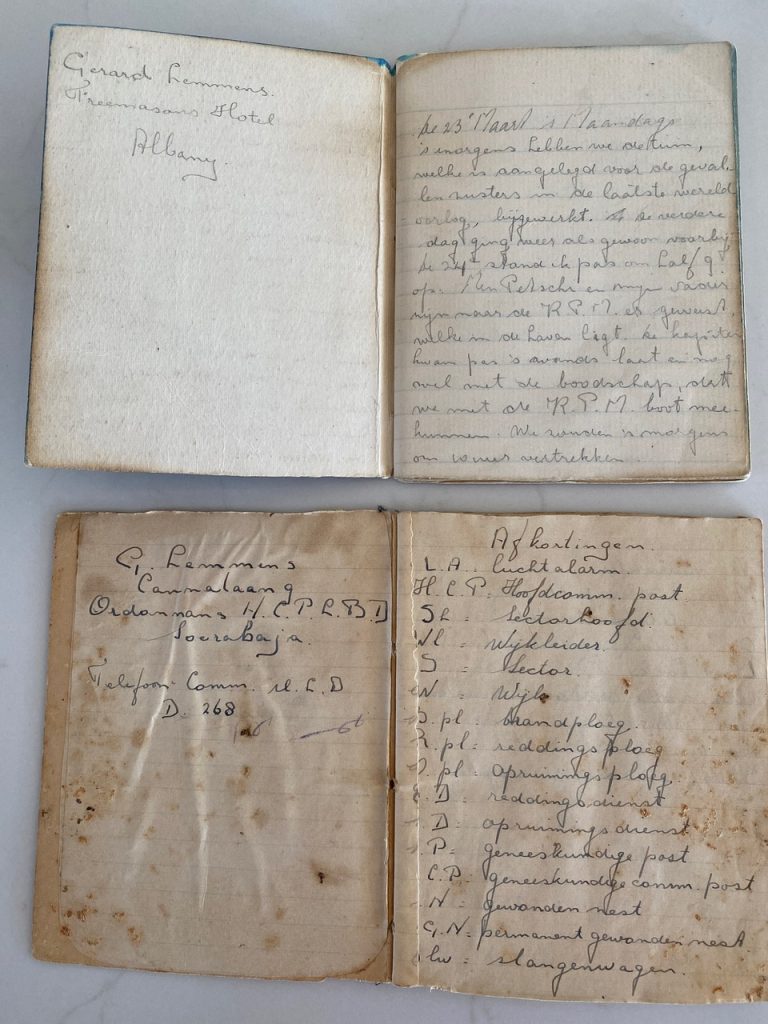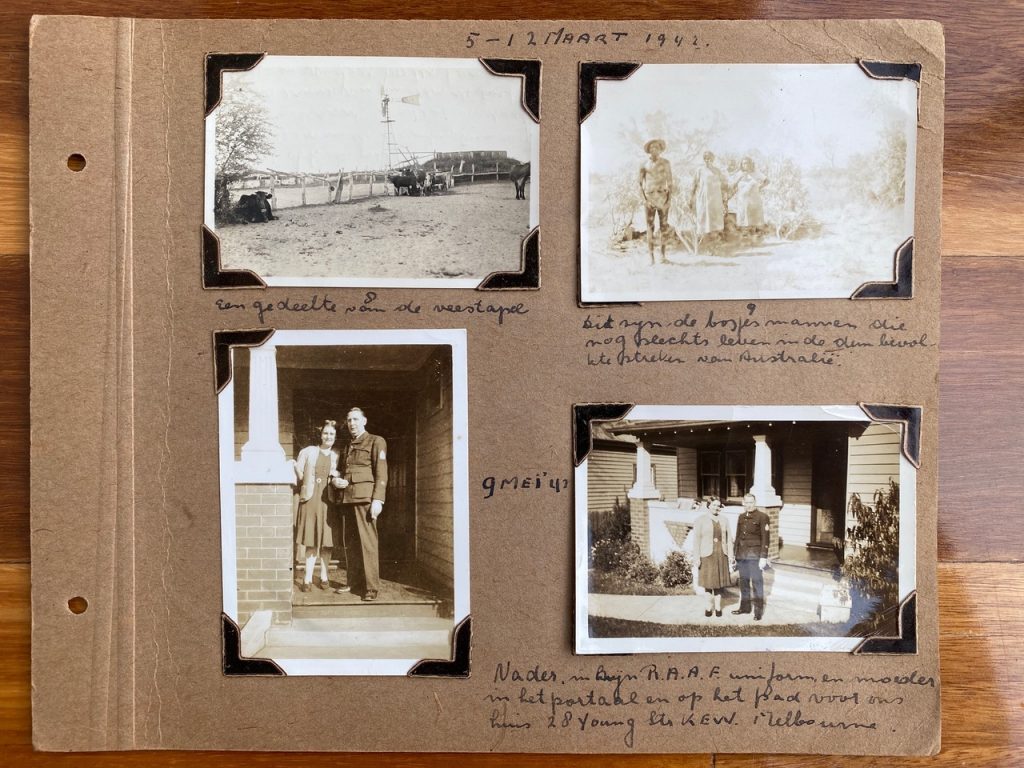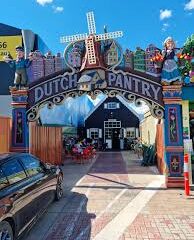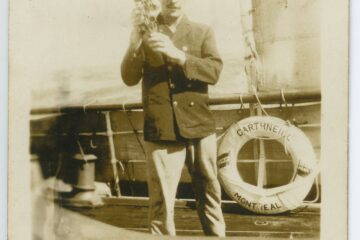Account of Journey from Soerabaia in Java to Australia during March 1942.
Written by: Gerard Lemmens at the age of 16 years. Translated from Dutch during May 1994 for the benefit and interest of my grandchildren.
Monday 2nd March 1942.
It was midday of Monday 2nd March. I had just returned home from doing my duties at the Headquarters of the Air raid Protection Service of Soerabaia. I was still in my Sea scout uniform when my father unexpectedly also came home. Earlier this day he had been advised that he would be evacuated to Australia together with other Dutch Navy personnel. (My father was Paymaster in the Navy). So, to see him come home came as a complete surprise. We were even more surprised when he told us that the families of the Navy personnel to be evacuated were also to travel to Australia. This was great news for as far as we could ascertain it would only be a matter of days before the Japanese forces occupied our city.
We were to be evacuated by flying boat from a secret departure point. Take off was to be 10p.m. this evening.
We were allowed half an hour to pack a small suitcase with only the most essential items. Whilst we did our packing, the car to take us to our take off point waited for us.
The previous night (Sunday 1st March) vital concerns such as the Navy Airforce base, Petroleum refineries etc. had been set afire by our own troops. By this time the Japanese had landed in several locations in Java and apparently our resistance could not be sustained much longer.
The car which took us to our departure location did not have any driving lights. The road we followed was crowded with cars and motorbikes, driven by mostly Navy personnel on their way to Tjilatjap on the south coast of Java. There they hoped to join a ship on its way to Australia.
Along the way we had an accident caused by the lack of driving lights. The car veered off the road and finished up on the railway tracks alongside the road. One of the passing cars pulled us off and we continued our way. We arrived at the departure point at 9.15p.m. The aircraft were on the river near the town of Lengkong (situated some 150 kilometres southwest of Soerabaia past the city of Mojokerto).
There were quite several families with children already there. We left at 10p.m. on one of three Dornier flying boats. The space on the aircraft was very confined with the twenty passengers on board. Through a window we could see the fires of the blazing refineries near Soerabaia. All lights on the plane were switched off which may have been just as well as at one stage the crew suspected an enemy aircraft flying in our vicinity.
Sleep did not come easily that night. It was with relief that the crew announced that we were nearing the coast of Australia. At this point of time, we had been flying for 7 1/2 hours.
At 6.15a.m. the captain announced the alarming news that the plane had used up all its available fuel and that we needed to make an emergency landing.
Tuesday 3rd March 1942.
We set down on the sea near the northwest coast of Australia. As soon as we had landed the Wireless Operator sent a message to the other Dornier planes requesting assistance. They replied that they had safely landed in Broome harbour and that they would assist as soon as possible. We waited the whole day on board our flying boat for the promised help but nothing eventuated.
At one stage we did see a Dornier aircraft flying over us at a great height. We were not seen. An hour or so later a small seaplane flew low over the water, again without seeing us. We could not identify its nationality so it may have been as well that it did not see us. By this time, it was midday and still we had not seen any sign of help.
We remained on board our aircraft as we expected help at any time. From where we were lying in the water, we could Lee land a good distance away. What we did not know was whether it was a reef, an island maybe occupied by the Japanese, or perhaps the mainland of Australia.
Again, an aircraft approached us, but this time from, the opposite direction to that of the earlier planes. It flew straight at us so there was a good chance that he could see us. After assuring himself that the aircraft was not Japanese, the Captain fired a flare in the air. The crew of the Lockheed, (as it turned out to be) thank goodness saw us. The plane circled around our position a number of times and during one pass it threw a note down to us, but the wind took hold of it and blew it out further to sea and out of our reach. But now we had hope again and that was a big relief. We had started to think that our position was pretty hopeless. We had been on the water for nearly a day now, and that with twenty people on board who had to exist in very cramped quarters with the sun blazing down. On top of this the weather turned rough and as a result half the passengers were seasick.
At 4p.m. it was decided that we should proceed to the visible land by using the rubber dinghies. These required to be pumped up with air. This took some time. When the task was completed, the dinghies were no longer required as ebb tide had set in and before us was a vast plain of water-covered sand negotiable by foot. Op to that time we had no knowledge of the dramatic rise and fall of the sea during ebb and flood). It took us 45 minutes to walk from the Dornier to the dunes, carrying suitcases and in full sun. When we arrived on the beach, we went into the dunes to look for some shade, but none was to be found. However, what we needed most was water and this also could not be found. Standing on the dunes provided us with a disconsolate picture. All we saw in front of us were more dunes and not a bit of shade. To the left and right of us, there were beaches extending beyond the reach of the eye. And behind us there was the sea. The fresh water that we had on board was by now nearly exhausted and rationing had to be instituted. Distillation equipment on the aircraft proved to be useless so no reliance could be placed on getting fresh water from that source.
As the sun began to set, we were looking forward to the cooler temperatures the night would provide. But the night was even worse than the day, caused by hordes of mosquitoes. One baby suffered more than anybody, despite incessant attention by the mother. The next morning the baby’s face, arms and legs were swollen beyond recognition. Sleep was not possible for any of us. We did bring the tent from the aircraft to the beach with the idea that we could shelter inside, away from the mosquitoes, but this was hopeless. The result was that nobody closed our eyes that night.
Wednesday 4th March.
This morning we retrieved the remaining suitcases from our aircraft and placed them on the beach near the tent. By now the fresh water supply was reduced to two bottles. ‘Each of us was allowed one spoonful of the water.
At approximately 10a.m. the Lockheed aircraft returned again. The crew threw a weighted parcel on the beach. This contained a message which stated that there was a possibility that either a boat and/or a car would come to deliver fuel for the Dornier and food and water for us.
The Lockheed crew were aware of our shortages of water etc. as on an earlier flyover they had thrown out a message requesting details of our requirements and to let them know on the 45-metre band. This was done with great haste.
On today’s message he also informed us that 200 yards north from where we were and then 4: mile inland from that point, we would find a watermill. We set off at once, with all available cans and bottles, to search for the mill.
The search developed into an arduous expedition. We had to climb up and down
dunes, which were covered with thorn bushes. Furthermore, it was the hottest part of the day and our thirst was getting worse. However, our labours were rewarded. We found the mill and with the mill was a large open tank full of water. We immediately quenched our thirst. Thinking back, the water was brackish, but at the time it was delicious.
Later this day the Lockheed returned again. This time it dropped all sorts of foodstuffs, tobacco, milk (for the baby) and water. The tank container for the latter burst open on impact and the fresh water disappeared in the sand. In a note with the provisions, he advised us that he would be back in an hour with more food etc. When he returned, he again dropped a message, this time to advise us that a car would come at 5.30p.m. to take us off the beach.
At 5p.m. the men from the car arrived. Due to the terrain they had to leave the car at the water mill. As they could not take the whole party, the women and children were to be transported first. The men would come the next day.
Carrying our satchels and cases we walked to the mill. From here we departed in the car. We travelled across the dunes following a kind of track which consisted of two ruts, where the car wheels had been before.
When we arrived at the Station the owner told us they had searched for us the previous evening and night. In fact, they had been to the water mill as well, but we had just left.
The name of the Station is Anna Plains and is located approximately 150 miles south of Broome and about 15 miles inland from the beach. During our trip from the watermill all we could see was one vast grass plain. We arrived at the Station at 9.30p.m.
After first taking a bath, we had our evening meal. It appears that meals in this area depend a lot on bread. Fruit and vegetables are scarce here.
For the time we were there, breakfasts consisted of Weeties and milk. This was something new to us, for wheatflakes were not known to us in Soerabaia. (Even now as I am translating this, whenever we have Weeties I think back to Anna Plains Station).
Thursday 5th March.
This morning the Station owner collected the men from the beach. They apparently experienced an even worse night than the night before as far as mosquitoes were concerned. At 4.30a.m. they had started to drag suitcases and any other required items from the Dornier to the beach. On completion of this they disabled the aircraft as there was no chance of it continuing on its journey.
From the Station residents we heard that there had been an attack on Broome by Japanese aircraft flying in from Timor. All our aircraft which were on the water at the time were destroyed. This included two of the planes which had left Java at the same time as us. They had only just arrived in Broome when the attack occurred. In addition to these two planes, ten others were also destroyed. Apparently, another Dornier had landed near a sheep pen.
Today 4 people arrived from Broome. They told us that 20 people had been killed and 40 wounded.
Friday 6th March.
This morning 3 trucks arrived from Broome. They had Allied troops on board, who were retreating from this area.
A telegram has been sent to Perth requesting that an aircraft be sent to pick us up.
Saturday 7th March.
Around midday more trucks with troops on board arrived at the Station. Amongst the troops were some Dutch people. They informed us that 14 women and children and 6 men had been killed on the 2 Dornier. Apparently, they were all still on board the aircraft when the Japanese attack took place.
The Station owner sent back one of the trucks to get provisions for the Station. With 20 extra people, food was running low.
For us life on the Station was much the same every day. We tried to assist the Station owner where possible. We listened to war communiques ever hopeful that we might be able to return. This was becoming more remote by the day, although one communique stated that an attack on $oerabaia had been repulsed. Another advised that Australian planes had attacked Timor from where the attack on Broome had originated.
Some of the crew of our Dornier together with the Station owner returned to the beached aircraft to retrieve a machine gun and ammunition. After disassembling the gun, greasing it and reassembling it, the gun was placed in position on the Station. It was to be used in case Japanese aircraft attacked Anna Plains.
Sunday 8th March.
During the evening we tuned in to the NIROM (the Dutch radio broadcasting station in Java) to learn the latest news. All we heard was that a broadcast in Javanese commenced after which German songs were being played. From this we assumed that the broadcasting station and for that matter Batavia (now known as Jakarta) has been occupied
Monday 9th March.
Today we have started to learn English. For this we are using Dutch Navy instruction booklets.
At midday a plane arrived to take us to Perth. Once again it was a Lockheed aircraft. The seating was limited to 12 passengers. This meant that only half of our group could travel. For our last evening together, we organised a farewell party. This consisted of dancing to the music from a gramophone.
Tuesday 10th March.
We rose early today, for the aircraft is due to take off at 5a.m.
After thanking the Station owner, his wife and his staff we set off for Perth.
End of Anna Plains episode.



80th commemoration – The Drama of Broome 3-3-1942
SBS Video – Broome March 1942 – Pilot Henk Hasselo and Navigator Frits van Hulsen remember. 8-3-2012


